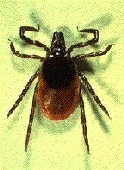
FRIDAY, Feb. 3 (HealthDay News) —
Areas in the United States where people have the highest risk of contracting Lyme disease are pinpointed in a new map created by the U.S. Centers for Disease Control and Prevention.
Lyme disease is one of the most rapidly emerging infectious diseases in North America. It’s transferred by ticks and symptoms range from headaches, fever and a rash to arthritis and Bell’s palsy, or damage to a facial nerve that can lead to temporary paralysis of the muscles on one side of the face.
The map shows that high infection risk is confined mainly to the Northeast and upper Midwest. There is a low risk in the South.
The map shows a clear risk of Lyme disease in large parts of the Northeast (including eastern Pennsylvania) from Maine going as far south as Maryland and northern Virginia.
The high risk area in the upper Midwest includes most of Wisconsin, a large part of northern Minnesota, and a small piece of northern Illinois.
The researchers also identified an emerging risk for Lyme disease along the Illinois/Indiana border, the New York/Vermont border, southwestern Michigan, and eastern North Dakota. There’s also evidence that Lyme disease is moving into central Virginia.
The map was created after the most extensive Lyme-related field study ever conducted. The results, published in the February issue of the American Journal of Tropical Medicine and Hygiene, offer public health and other officials critical information on local risk.
“There has been a lot of discussion of whether Lyme disease exists outside of the Northeast and the upper Midwest, but our sampling of tick populations at hundreds of sites suggests that any diagnosis of Lyme disease in most of the South should be put in serious doubt, unless it involves someone who has traveled to an area where the disease is common,” lead author Dr. Maria Diuk-Wasser, an assistant professor at the Yale School of Public Health, said in a journal news release.
“We can’t completely rule out the existence of Lyme disease in the South, but it appears highly unlikely,” she added.
More information
The American Academy of Family Physicians has more about Lyme disease.

